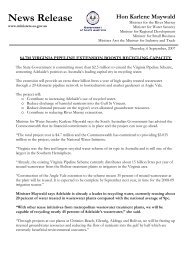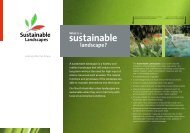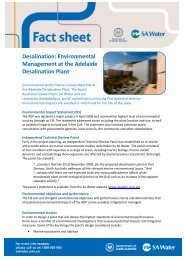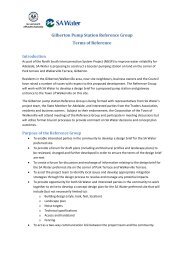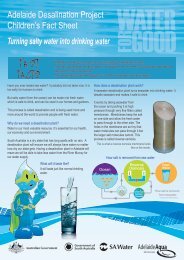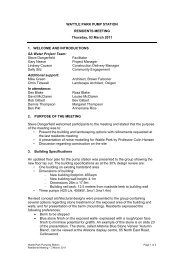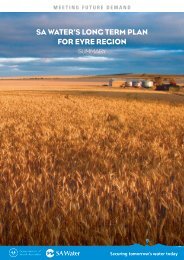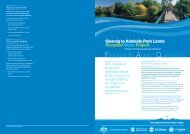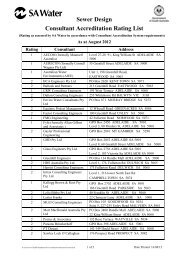Water for Growth - SA Water
Water for Growth - SA Water
Water for Growth - SA Water
- No tags were found...
Create successful ePaper yourself
Turn your PDF publications into a flip-book with our unique Google optimized e-Paper software.
Beetaloo, Bundaleer and Baroota reservoirs were constructedfrom the late 1800s onwards to provide Port Pirie andsurrounding areas with the water desperately needed <strong>for</strong>growth. Life <strong>for</strong> workers involved in the construction ofthese reservoirs was tough - living in cramped makeshiftcamps <strong>for</strong> many months, even years on end.WATER FOR GROWTH<strong>SA</strong> WATER - CELEBRATING 150 YEAR<strong>SA</strong> camp of tents providing accommodation<strong>for</strong> senior staff working on a new reservoir(late 19th century).Ref: PRG 280/1/5/211Photograph courtesy of theState Library of South Australia
WATER FOR GROWTH<strong>SA</strong> WATER - CELEBRATING 150 YEARSBEETALOO RESERVOIRBeetaloo was the largest concrete dam tobe attempted in the southern hemispherein the 1880s. It was built to supply waterto Port Pirie, the northern towns ofYorke Peninsula and surrounding areas.Its ambitious design and use of differentmaterials meant that much of the machineryand plant was specially designed andmanufactured by the <strong>Water</strong>works andDrainage Commission (now <strong>SA</strong> <strong>Water</strong>).At the time, Port Pirie was in the grip ofsevere drought and the construction of thedam provided employment <strong>for</strong> 400 men.BEETALOO FACTSLocation: 19km east of Port Pirie onCrystal BrookBuilt: 1886 - 1890Height: 32.8mCatchment area: 48 square kmsBUNDALEER RESERVOIRIn 1897, cries <strong>for</strong> more water were heardfrom the towns of Snowtown, Redhill,Brinkworth, Blythe and Port Wakefield.The supply from the Beetaloo Reservoirhad proven inadequate <strong>for</strong> such a large area.Bundaleer Reservoir was constructed in asmall valley five kilometres north of thejunction of Bundaleer Creek and the RiverBroughton. Under the original schemea network of pipes distributed water toapproximately 243,000 hectares reachingRedhill, Balaklava, Snowtown, Brinkworth,Port Wakefield and adjacent hundreds.BUNDALEER FACTSLocation: 58 km south east of Port PirieBuilt: 1898 - 1903Length of reservoir crest: 333.45mTotal catchment area: 1567 square kmsBAROOTA RESERVOIRDespite the construction of Beetaloo andBundaleer reservoirs, the pace of growth in thetown of Port Pirie was faster than the watersupply. Industry in the town was dependenton a continuous, reliable source of water, andannual consumption in Port Pirie increased from40 megalitres in 1909 to 160 megalitres in 1913.A new source of water needed to be foundquickly. After many years of delayeddecisions and feasibility studies, BarootaCreek was dammed. Baroota Reservoir wascompleted in December 1921, supplying amuch valued resource to Port Pirie.BAROOTA FACTSBuilt 1916 - 1921Height: 30.5mCatchment area: 136 square kmsAbove - Workers on the Beetaloo Reservoir,at P.F. Smith’s Restaurant. C1886.Above middle - Bundaleer <strong>Water</strong>worksBroughton River weir seven minutes after gateswere opened. 27 November 1903.Above right - Bundaleer <strong>Water</strong>works,camp, looking North. C1900.LIFE IN A CONSTRUCTION CAMPDuring the construction of major reservoirs,pipelines and other infrastructure a hugeamount of labour was required, especially inthe early days where much of the work wasundertaken by hand. Typically men were sentto live in camps close to the construction sitesin large numbers. As a result, makeshift townssprang up around the camps.At Bundaleer we know life was tough <strong>for</strong> the500 workers at the site. Men were packedinto flimsy tents, often living in verycramped quarters. By the end of 1898, thecampsite at Bundaleer included threebutchers, three bakers, three cool drink sellers,a shoemaker, draper, doctor and police station.A cricket club was also <strong>for</strong>med, and aschoolroom provided.Workers had to cook their own meals, paidsixpence a week <strong>for</strong> the rent of their tentsand sixpence a week <strong>for</strong> a wood supply. Duringconstruction, six men lost their lives inaccidents and fifty one cases of typhoid feverwere admitted to Jamestown Hospital.



